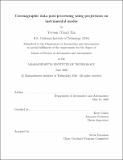Coronagraphic data post-processing using projections on instrumental modes
Author(s)
Xin, Yeyuan(Yeyuan Yinzi)
Download1191836232-MIT.pdf (5.678Mb)
Other Contributors
Massachusetts Institute of Technology. Department of Aeronautics and Astronautics.
Advisor
Kerri Cahoy.
Terms of use
Metadata
Show full item recordAbstract
High contrast astronomy has yielded the direct observations of over a dozen exoplanets and a multitude of brown dwarfs and circumstellar disks. Despite advances in coronagraphy and wavefront control, high contrast observations are still plagued by residual wavefront aberrations. Post-processing techniques can provide an additional boost in separating residual aberrations from an astrophysical signal. This work explores using a coronagraph instrument model to guide post-processing. We consider the propagation of signals and wavefront error through a coronagraphic instrument, and approach the post-processing problem using "robust observables." We model and approximate the instrument response function of a classical Lyot coronagraph (CLC) and find from it a projection that removes the dominant error modes. We use this projection to post-process synthetically generated data, and assess the performance of the new model-based post-processing approach compared to using the raw intensity data by calculating their respective flux ratio detection limits. We extend our analysis to include the presence of a dark hole using a simulation of the CLC on the High-contrast imager for complex aperture telescopes (HiCAT) testbed. We find that for non-time-correlated wavefront errors, using the robust observables modestly increases our sensitivity to the signal of a binary companion for most of the range of separations over which our treatment is valid, for example, by up to 50% at 7.5[lambda]/D. For time-correlated wavefront errors, the results vary depending on the test statistic used and degree of correlation. The modest improvement using robust observables with non-time-correlated errors is shown to extend to a CLC with a dark hole created by the stroke minimization algorithm. Future work exploring the inclusion of statistical whitening processes will allow for a more complete characterization of the robust observables with time-correlated noise. We discuss the dimensionality of coronagraph self-calibration problem and motivate future directions in the joint study of coronagraphy and post-processing.
Description
Thesis: S.M., Massachusetts Institute of Technology, Department of Aeronautics and Astronautics, May, 2020 Cataloged from the official PDF of thesis. Includes bibliographical references (pages 71-76).
Date issued
2020Department
Massachusetts Institute of Technology. Department of Aeronautics and AstronauticsPublisher
Massachusetts Institute of Technology
Keywords
Aeronautics and Astronautics.